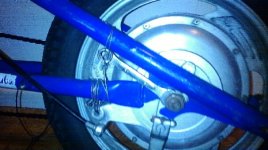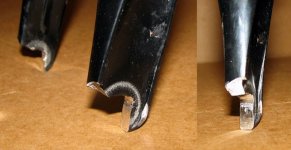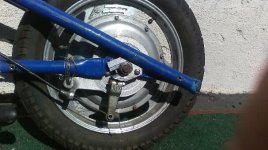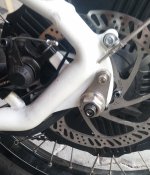Faced with trying to design torque arms for for my newly installed Jumper front hub motor, and faced with the fact that there is not enough spindle length to fit anything inside the wheel nuts,
I came up with this simple idea, and would like to know if it will work or not and with reasons why not.
Simply weld an 18mm socket to a bar about 12" long by 3/8" by 1" bar in such a way that the bar fits tightly against the forks, this probably means grinding the back off the socket so that it is the right width to fit snug on the nut and aligns along the forks.
The torque arm would look like a box end 18mm wrench. clamped to the forks it would strengthen the forks which of course addresses one of the major objections to front wheel hub motors.
The immediate reaction I get is people think its purpose is to stop the spindle nuts loosening, while it does do that the main purpose is to stop the spindle nut from moving fore and aft or up and down.
IMO the pro's are
works with and adds to the stability of the torqued spindle nut, and it's ability to stop the spindle from rocking.
Does not take up space on a spindle that is too short.
Strengthen the fork legs,
Eliminates the need to carry a wrench for the spindle nuts :-}
Repeat that the main purpose is not to stop the nuts backing off, that can be done with thread locker, or nylock nuts, altho on my bike I ground down the nut so that the mylon engaged with the thread with this torque arm that ceases to be important.
I came up with this simple idea, and would like to know if it will work or not and with reasons why not.
Simply weld an 18mm socket to a bar about 12" long by 3/8" by 1" bar in such a way that the bar fits tightly against the forks, this probably means grinding the back off the socket so that it is the right width to fit snug on the nut and aligns along the forks.
The torque arm would look like a box end 18mm wrench. clamped to the forks it would strengthen the forks which of course addresses one of the major objections to front wheel hub motors.
The immediate reaction I get is people think its purpose is to stop the spindle nuts loosening, while it does do that the main purpose is to stop the spindle nut from moving fore and aft or up and down.
IMO the pro's are
works with and adds to the stability of the torqued spindle nut, and it's ability to stop the spindle from rocking.
Does not take up space on a spindle that is too short.
Strengthen the fork legs,
Eliminates the need to carry a wrench for the spindle nuts :-}
Repeat that the main purpose is not to stop the nuts backing off, that can be done with thread locker, or nylock nuts, altho on my bike I ground down the nut so that the mylon engaged with the thread with this torque arm that ceases to be important.







